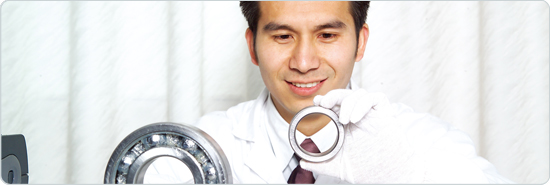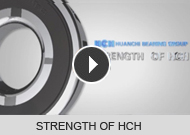- Main Clients and markets
- Customer Service
- Bearing Selection services
- Bearing Handling Service
- Bearing Fitting Service
- Lubrication Service
- Preload
-
Bearing cleanliness

To confirm that the bearing has been mounted correctly, perform a rotation check.
① First, rotate the shaft or housing to see whether anything unusual can be detected.
② Next, engage the bearing without applying a load, observing its rotational condition at low speed.
③ Then, slowly increase the rotational speed and load while checking for any rise in operational noise levels,
vibrations and temperature.
● Noise inspection
Unusual noise or noise levels checking should be performed by well-trained staff who is familiar with the sound of properly mounted bearings operated under standard conditions. A clear, smooth and continuous running sound is normal. A high, metallic or irregular sound indicates some error in function. Vibration can be accurately checked with a vibration measuring instrument, and the amplitude and frequency characteristics measured against a fixed standard.
| Irregularities | Possible Causes | Countermeasures | |
| Noise |
Loud Metallic Sound |
Abnormal Load | Correction of fit, internal clearance, preload, position of housing shoulder, etc. |
| Incorrect mounting | Correction of alignment of shaft and housing, accuracy of mounting method. | ||
| Insufficient or improper lubricant | Replenish lubricant or select proper lubricant. | ||
| Squeaking noise | Replacement by low-noise bearings, selection of small clearance bearings. | ||
| Sliding of balls | Adjustment of preload, selection of small clearance bearings, or adoption of softer grease. | ||
|
Loud Regular Sound |
Contact of rotating parts | Correction of labyrinth seal, etc. | |
| Flaws, corrosion, or scratches on the raceways | Replacement of bearing, cleaning, improvement of sals, and usage of clean lubricant. | ||
| Brinelling | Replacement of bearing and careful handling. | ||
| Flaking on the raceways | Replacement of bearing | ||
|
Irregular Sound |
Excessive clearance | Correction of fit and clearance and correction of preload | |
| Penetration by foreign particles | Replacement of bearing, cleaning, improvement of seals, and relubrication using clean lubricant. | ||
| Flaws or flaking on the ball surfaces | Replacement of bearing | ||
| Excessive amount of lubricant | Reduce amount of lubricant, select stiffer grease. | ||
|
Abnormal Temperature Rise |
Insufficient or improper lubricant | Replenish lubricant or select proper lubricant. | |
| Abnormal load | Correction of fit, internal clearance, preload, position of housing shoulder. | ||
| Incorrect mounting | Correction of alignment of shaft and housing, accuracy of mounting, or mounting method. | ||
| Creep of fitted surfaces, excessive seal friction. | Correction of seals, replacement of bearing, correction of fit or mounting. | ||
| Vibration | Brinelling | Replacement of bearings and careful handling. | |
| Flaking | Replacement of bearing | ||
| Incorrect mounting | Correction of squareness between shaft and housing shoulder or side of spacer | ||
| Penetration by foreign particles | Replacement of bearing, cleaning, correction of seals. | ||
|
Leakage or Discoloration of |
To much lubrication. Penetration by foreign particles or abrasion chips. | Reduce amount of lubricant, select stiffer grease. Replace bearing or lubricant. Clean housing and adjacent parts. | |
● Temperature inspection
Another method for for post installation running test is by temperature variation. Usually the bearing temperature can be estimated from the housing surface temperature. However, if the bearing outer ring is accessible through oil inlets, etc., the temperature can be more accurately measured. Under normal conditions, bearing temperature rises with rotation time and then reaches a stable operating temperature after a certain period of time. If the temperature does not level off and continues to rise, or if there is a sudden temperature rise, or if the temperature is unusually high, the bearing should be inspected.
● Running Traces inspection
As the bearing rotates, the raceways of the inner ring and the outer ring make contact with the rolling elements. This results in a wear path on both the rolling elements and raceways. It is normal for the running trace to be marked on the raceway, and the extent and shape of this running trace provides a useful indication of loading conditions.
It is possible to determine from careful observation of the running traces whether the bearing is carrying a radial load, a large axial load, or a moment load, or if there is extreme rigidity variations of the housing. Unexpected load applied on the bearing or excessive mounting error or the like can also be determined, providing a clue to the investigation of causes for bearing failure.

Representative running traces of deep groove ball bearings are shown in above chart. Above chart (a) to (d), show general running traces under radial load or axial load. The running traces vary according to whether the load is fixed to the inner ring or the outer ring, and according to load conditions. Running traces (e) to (h) often cause bearing failure, and must be carefully observed.
● (e) shows running traces with a shaft inclined due to misalignment.
● (f) is a running trace under a moment load.
● (g) is a running trace in a housing which is elliptically shaped and has poor inner diameter accuracy.
●(h) is a running trace in a bearing with insufficient internal clearance.




